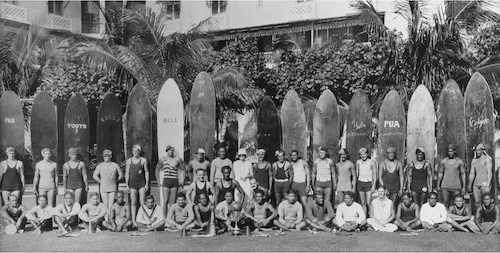History
Waikiki’s Beach Boys: The Watermen Who Shared Aloha with the World
Image courtesy of Aloha Surf Guide
Waikiki’s Beach Boys: The Watermen Who Shared Aloha with the World
Before surfing became a global phenomenon, before surfboards had fins or brands, there were the Waikiki Beach Boys — a brotherhood of Hawaiian watermen who lived by the tides and taught the world the meaning of aloha.
In the early 1900s, these men made their home along the sands of Waikiki. They paddled outrigger canoes, fished, surfed, sang, and shared stories under the palms. But most importantly, they taught visitors how to ride the waves — and in doing so, they introduced the world to Hawaiʻi’s most enduring gift: surfing.
The Origins of the Waikiki Beach Boys
At the turn of the 20th century, tourism was just beginning to reach Hawaiʻi. Waikiki, with its gentle breaks and golden sands, became a gathering place for skilled Hawaiian watermen. Locals began calling them the Waikiki Beach Boys, though they were far more than guides — they were lifeguards, surfers, musicians, storytellers, and protectors of the ocean.
Many came from families who had surfed for generations. They carried forward knowledge passed down through chants and practice — how to read swells, when to paddle, where the reefs lay hidden beneath the water’s shimmer.
Their names became part of local legend: “Steamboat” Mokuahi, Chick Daniels, Blue Makua, Rabbit Kekai, and many others. Together, they formed the living heartbeat of Waikiki’s shoreline.
Duke Kahanamoku and His Brothers of the Sea
Among the Waikiki Beach Boys stood one of the most famous Hawaiians in history — Duke Kahanamoku. Though known to the world as an Olympic champion, Duke was first and always a beach boy at heart.
He and his friends shared surfing with visiting guests, often pushing tourists into their first waves by hand. Duke’s humility, combined with his deep aloha, made him the perfect ambassador of Hawaiian surfing. Yet he never stood apart from his peers — the other Beach Boys were his brothers, his hui, his crew.
Together, they transformed Waikiki into the birthplace of modern surf culture — a place where every wave was both sport and ceremony.
Life on the Beach in the 1920s and 1930s
Life as a Waikiki Beach Boy wasn’t glamorous by modern standards, but it was rich in rhythm and connection. Mornings began with surf lessons or canoe rides for hotel guests. Midday brought fishing or board repairs under the coconut trees. Afternoons might mean playing music for visitors, or watching over swimmers as informal lifeguards.
Their lives flowed with the ocean — one foot in tradition, one in the changing world of tourism. They lived by the Hawaiian concept of kuleana: a sense of responsibility to care for others and for the sea.
As Honolulu grew and the hotels along Kalākaua Avenue expanded, the Beach Boys became the bridge between Hawaiian culture and curious travelers. They didn’t just teach surfing — they taught respect, humility, and joy in the water.
How the Waikiki Beach Boys Shaped Surfing’s Global Image
Long before surf competitions or brand logos, the Waikiki Beach Boys set the tone for what surfing would mean to the world. Their smiles, songs, and spirit of aloha turned Waikiki into a living postcard — and surfing into something universal.
Photographs from the era show them standing tall with massive wooden boards, poised against Diamond Head’s backdrop. To visitors, they represented freedom and grace. To Hawaiians, they represented continuity — the survival of an ancient ocean art in a modern age.
By the mid-20th century, their influence had spread far beyond Oʻahu. Surfers in California, Australia, and beyond all traced their roots back to Waikiki’s gentle rollers — and to the Beach Boys who showed them the way.
The Legacy Lives On
Today, you can still feel their legacy in Waikiki. The canoes still line the beach. Surf instructors still wait near the Moana and the Royal Hawaiian, calling out lessons just as their predecessors did nearly a century ago.
The Waikiki Beach Boys may have passed on, but their mana remains in the salt spray and laughter of every beginner who stands up for the first time.
They were more than teachers. They were guardians of aloha — and the waves they shared continue to carry their story.
Learn More (Archival & Historical Sources)
-
Duke Kahanamoku — Wikipedia (en.wikipedia.org)
-
Rabbit Kekai — Wikipedia (en.wikipedia.org)
-
The Waikiki Beach Boys … A Look Back — AlohaSurfGuide (alohasurfguide.com)
-
Digital Archives of Hawaiʻi – Beach Boys Collection (digitalarchives.hawaii.gov)
-
Historic Hawaii Foundation — Original Waikiki Beach Boys Exhibition (historichawaiifoundationnews.blogspot.com)
-
LA Times — “Beach Boy Forever” (latimes.com)
-
Hawaii Magazine — How Waikiki’s Legendary Beach Boys Defined Aloha (hawaiimagazine.com)
-
Hui Nalu, Beachboys, and the Surfing Board-lands of Hawai‘i (jeffreycjohnson.org PDF)
-
Waikiki Beach Services — History of Surfing in Hawaiʻi (waikikibeachservices.com)

